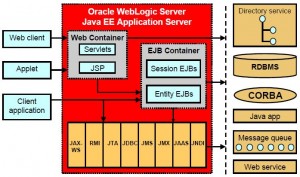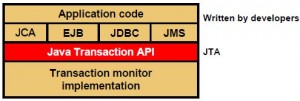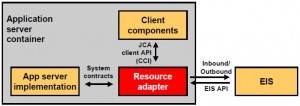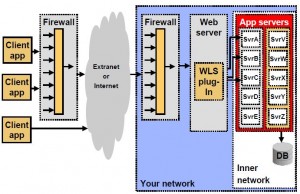This is part of 1Z1-102: Oracle Weblogic Server 11g: System Administration I
<< Previous
Describe the Technologies in Java Enterprise Edition (JEE)
Distributed Systems
* Distributed systems divide the work among multiple independent modules
* Failure of a single system does not bring down the whole system
* Distributed systems are more
– Available
– Scalable
– Maintainable
J2EE Architecture
Web Application Technologies
* Servlet
* JSP
* JSTL
* JSF
* Debugging Support for Other Languages
Web Services Technologies
* JAX-RPC
* JAX-WS
* JAX-RS
* JAXB
* Implementing Enterprise Web Services
* Web Services metadata for the Java Platform
* JAX-Messaging
* JAX-R (Registry)
Enterprise Application Technologies
* Contexts and Dependency Injection for Java (CDI, Web Beans)
* DI for Java
* Bean Validation
* EJB
* JCA
* Java Persistence (JPA)
* Common Annotations for the Java Platform
* JMS
* JTA
* JavaMail
* JNDI
Management and Security Technologies
* Java Authentication Service Provider Interface for Containers
* Java Authorization Contract for Containers
* Java EE Application Deployment
* J2EE Management
Java EE Related Specs in Java SE
* JAXP
* JDBC
* JMX
* JAF
* StAX
EJB
* Distributed components written in Java
* Have well defined interface
JDBC
* Standard Java interface for accessing heterogeneous databases
JNDI
* Java API for accessing naming and directory services
* Built as a layer over DNS, LDAP, and so on
* Used to lookup JEE objects: EJB home stubs, JDBC data source, JMS connection factories and destinations, RMI stubs
JTA
* Java API for demarcating transactions within a program
JMS
* Java API for accessing message oriented middleware (MOM)
* Supports
– point-to-point
– publish-subscribe
– guaranteed message delivery
– transaction participation
– dynamically configurable services
– application or system scoped services
– interop with other messaging systems
JAAS
* Java based security management framework
* Support
– SSO (single sign on)
– PAM (pluggable authentication module)
* Enables flexible control over authorization based on
– users
– groups
– roles
JMX (Java Management Extension)
* Defines a standard infrastructure to manage a device from Java programs
* Decouples managed service from management tools (much like JDBC decouple data service from RDBMS)
* Based on MBeans which are building blocks of JMX
JCA (Java Connector Architecture)
* JCA connects EIS with JEE container through resource adapters
* Resource adapters can be deployed in a RAR (resource adapter archive)
Client Application
* Client application interacts with WLS through:
– JRMP/T3: RMI implementation
– IIOP:
– jCOM: allows bidirectional access between Java/J2EE objects and Microsoft Active X components
* Client types:
– Stand-alone Java applications
– Applets within a browser
Web Client
* A web client interacts with WLS via HTTP using servlets or JSP
* Two types of web clients:
– Web browser
– Web services
Proxy Server
* Forward requests to other machines
* Can be used as a level of indirection and security (decouples client from actual servers)
* Can be used to load balance a system
* A reverse proxy is a web page cache
Web Server
* Provides web content
* Communicate via HTTP, FTP, etc.
* Can also handle CGI requests
* Also can proxy some requests to app servers
Fire Walls
* Provides filtering, authentication, authorization services
* Help keep out hackers
* Map port requests
* Also can act as proxy servers
* Can decrease back-end network activity
App Servers
* Provide run time engine for deployed applications
* Handles heavier processing chores than web servers
Web Application Server Configuration
Next >> Installing Oracle WebLogic Server 11g
[mv_include id=’3268′]





Hiya very cool website!! Guy .. Excellent .. Amazing
.. I will bookmark your website and take the feeds also?
I’m happy to search out a lot of helpful information right here within the submit, we’d like work out extra techniques on this regard, thanks for sharing.
. . . . .
I could not in a million years slaughter myself. I approve of suicide if you take offensive health. Otherwise it’s the last hissy fit rh7050 http://canpharm.top viagra free sample uy9860xy3324